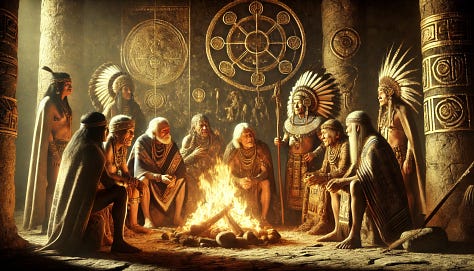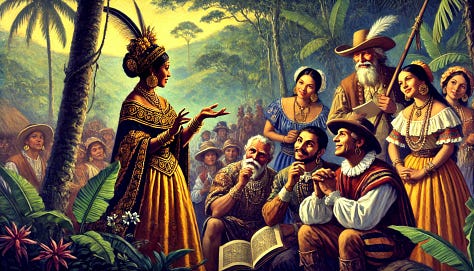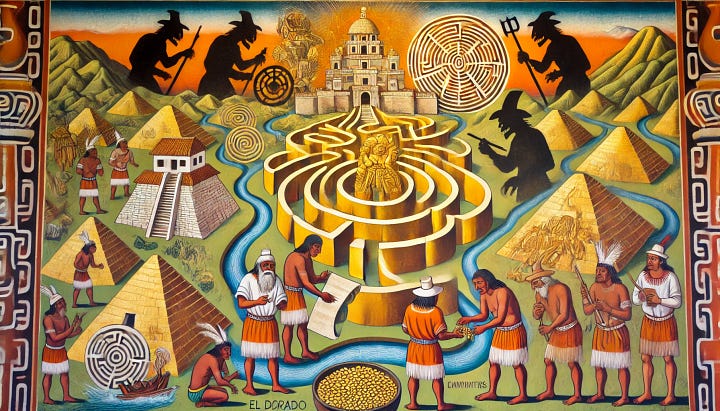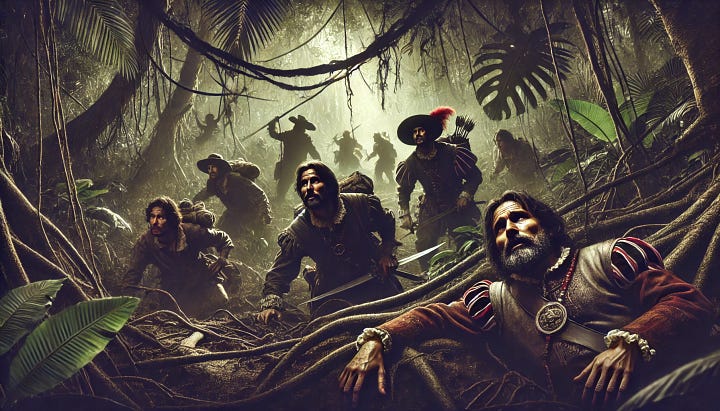Archaeological Report: The Muisca Tablets of Deception and the Origin of El Dorado
An excersice in fiction ...
Site Identification: Lake Guatavita, Cundinamarca, Colombia
Date of Excavation: June 14, 2024 – September 27, 2024
Lead Archaeologist: Dr. Isabella Martinez, University of Bogotá
Co-Investigators: Prof. Miguel Alvarez, Linguistics Expert; Dr. Sofia Herrera, Cultural Anthropologist
---
Abstract
During the recent excavation at Lake Guatavita, a set of ancient stone tablets, pottery fragments, and ritualistic artifacts were uncovered, revealing groundbreaking insights into the origins of the El Dorado legend. These artifacts contain inscriptions and carvings in the Chibcha language, providing evidence that the Muisca people ingeniously crafted the myth of El Dorado as a strategic weapon to exploit the conquistadors’ insatiable greed, ultimately leading them to their demise. This discovery challenges the long-held belief of El Dorado as merely a tale of gold and exposes its historical role as a calculated act of resistance and survival against Spanish colonization.
---
Background and Context
The Muisca civilization, known for their advanced metallurgy and intricate rituals, occupied the highlands of modern-day Colombia long before the arrival of Spanish conquistadors. They were among the principal creators of the El Dorado myth, which lured countless explorers to their deaths in the Amazonian jungles. Previous research suggested this legend was rooted in ritualistic ceremonies, particularly the initiation of a new Zipa (leader), who would cover himself in gold dust before diving into Lake Guatavita.
However, the new findings propose a radical reinterpretation: El Dorado was deliberately fabricated as a strategic deception to manipulate and destroy the invaders through their own greed.
---
Discovery and Description of Artifacts
1. The Tablets of Deception (Hueca Neptaya)
Quantity and Composition: Seven rectangular stone tablets carved from local andesite, each measuring approximately 50 cm by 30 cm.
Location: Found buried along the northern edge of Lake Guatavita in a semi-circular arrangement, possibly indicating a ceremonial purpose.
Condition and Preservation: The tablets are remarkably well-preserved, protected by sediment layers which shielded them from erosion.
2. Pottery Fragments and Ritual Artifacts
Description: Fragments of intricately decorated pottery were discovered nearby, depicting scenes of feasting and ceremonial gatherings. Several gold dust containers and ceremonial headdresses were also recovered.
Symbolism: The imagery on the pottery illustrates a narrative of entrapment and sacrifice, consistent with the themes found in the tablets.
---
Translation and Interpretation of the Texts
The inscriptions on the Hueca Neptaya were meticulously translated using known Chibcha lexicons. They recount a deliberate act of narrative construction by the Muisca elders in response to the catastrophic impact of the Spanish incursion, including:
Recognition of Mortal Threats: The texts express awareness of the conquistadors’ superior weaponry (described as “thundersticks”) and the devastating effects of disease (referred to as the “invisible death”).
Strategic Invention of El Dorado: The tablets reveal that the Muisca rulers held council and concluded that they could not defeat the Spanish militarily. Instead, they devised a plan to manipulate the Spaniards’ greed for gold.
Dissemination Through Cultural Diplomacy: It was decreed that the legend would be propagated through Muisca women, who were deliberately married or enslaved by the conquistadors. These women, acting as covert agents, spread the myth by weaving tales of a city made entirely of gold, using the conquistadors' own cultural fascination with wealth against them.
Rituals as Tools of Deception: The tablets describe the ceremonial practices of gold dust anointment and offerings at Lake Guatavita as calculated performances designed to validate and amplify the fabricated legend.
---
The Grand Design: A Trap of Greed
The narrative strategy embedded within the legend was ingeniously crafted to exploit the psychological vulnerabilities of the conquistadors:
False Trails and Death Marches: The tablets explain that the myth of El Dorado was intentionally vague, designed to send explorers on perilous journeys into the hostile Amazonian wilderness, where they would face starvation, disease, and predation by unfamiliar wildlife.
Destruction Through Obsession: Several passages recount how the Muisca shamanic leaders foresaw the Spaniards' insatiable greed would lead to their own destruction, causing them to turn on one another in madness and betrayal.
---
Historical Implications and Conclusion
The discovery of the Hueca Neptaya fundamentally reconfigures our understanding of the El Dorado myth. Far from being a mere cultural narrative, it emerges as a sophisticated act of psychological warfare. The Muisca people, recognizing their inability to resist the Spanish through force, weaponized storytelling as a last stand to protect their civilization.
This deliberate construction of a myth that exploited the conquistadors' own flaws and obsessions stands as a testament to the Muisca's ingenuity, resilience, and strategic brilliance. It was not merely a legend of gold, but a narrative trap, leading the Spanish to their doom, swallowed by the very jungles they sought to conquer.
---
Recommendations for Further Study
Linguistic Analysis: A detailed linguistic study is recommended to fully decode symbolic language and poetic devices used within the inscriptions.
Cultural Anthropology: Further exploration of how Muisca oral traditions contributed to the dissemination and preservation of the El Dorado myth.
Comparative Analysis: Comparing this narrative strategy with other indigenous resistance techniques across the Americas could provide broader insights into anti-colonial resistance tactics.
---





Acknowledgments
We thank the Colombian Ministry of Culture and the local Indigenous Councils for their support and guidance throughout the excavation process. Our gratitude also extends to the descendants of the Muisca people, whose cultural legacy continues to inspire and educate.
---
References
1. Alvarez, M., & Herrera, S. (2025). The Muisca Legacy: Language, Power, and Resistance. University of Bogotá Press.
2. Martinez, I. (2024). El Dorado Unveiled: Myths as Weapons of War. Archaeological Review, 58(4), 421-439.
3. Torres, J. (2023). The Chibcha Language: Decoding Ancient Strategies. Linguistic Horzions Journal, 27(2), 198-212.



